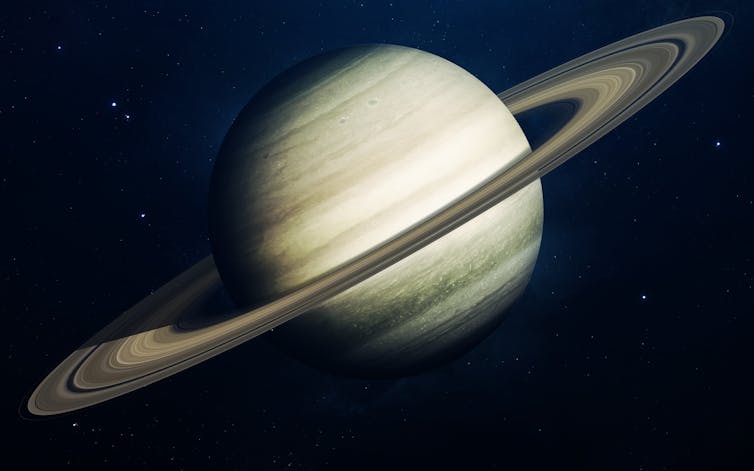Curious Kids: why are some planets surrounded by rings?

Curious Kids is a series for children in which we ask experts to answer questions from kids.
Why do Uranus and other planets have rings around them? (Lesedi, 6, Soweto)
For a very long time, Saturn was thought to be the only planet in our solar system with rings. The rings around Saturn were discovered by an astronomer called Galileo Galilei nearly 400 years ago. He used a very simple telescope that he constructed himself from lenses and pointed it at the planets in the night sky. One of the first objects he looked at was Saturn. At first he thought that Saturn had two large moons on either side of the planet because his telescope wasn’t very good and only produced very blurry images.
Since then, astronomers – who study the universe and everything in it, like planets – have used bigger and better telescopes to find rings around all of the outer gas giant planets: Jupiter, Saturn, Neptune and Uranus. These planets, unlike others in our system, consist largely of gas.
We’re not sure how the rings work or how they formed, but there are a few theories.
Different theories
The first theory states that the rings formed at the same time as the planet. Some particles of gas and dust that the planets are made of were too far away from the core of the planet and could not be squashed together by gravity. They remained behind to form the ring system.
The second theory, and my personal favourite, is that the rings were formed when two of the moons of the planet, which had formed at the same time as the planet, somehow got disturbed in their orbits and eventually crashed into each other (an orbit is the circular path that the moon travels on around the planet). The stuff that was left behind in this huge smash could not come together again to form a new moon. Instead, it spread out into the ring systems we see today.
Since we don’t have the answers yet, we keep exploring and testing different theories.
What we do know is that the rings around the various planets are all slightly different from one another, but they all share some characteristics too.
First, they are all much wider than they are thick. The rings of Saturn, for example, are about 280,000km wide (stretching away from the planet) but only 200 metres thick. That’s like having a normal pancake on your plate for breakfast that is 14km wide.
The other thing that all rings systems share is that they are all made of small particles of ice and rock. The smallest of these particles are no bigger than dust grains, while the largest of the particles are about 20 metres in diameter – about the size of a school hall. All the rings around the planets also contain gaps that are sometimes many kilometres wide and at first nobody could figure out why. We later learned that the gaps were caused by small moons that had gobbled up all the material in that particular part of the ring system.
The biggest difference between the rings of Saturn and the other gas giant planets is that the particles that make up the rings of Saturn are very good at reflecting the light from the sun back towards the Earth. That means they appear to be very bright, which is why we can see the rings from Earth using a normal telescope. The extremely large number of particles trapped in the rings of Saturn also make the rings much bigger and wider; that’s another reason they’re easier to see than the rings of the other gas giant planets.
The particles that make up the rings of Uranus and Neptune contain elements that were darkened by the sun. These dark particles look very similar to pieces of coal or charcoal like you’d use to make a fire. This makes them much more difficult to see because they don’t reflect as much of the sun’s light back to us.
New discoveries
This is an exciting time for astronomy. More and more satellites and space probes are being launched from all over the world, which allows us to investigate the outer planets of our solar system. That means astronomers will have the chance to study these rings – and one day, hopefully, we’ll be able to answer all of your questions and more.
Hello, curious kids! Have you got a question you’d like an expert to answer? Ask an adult to send your question to africa-curiouskids@theconversation.com. Please tell us your name, age, and which city you live in. We won’t be able to answer every question but we will do our best.![]()
Dr Rudi Kuhn, SALT Astronomer, South African Astronomical Observatory
This article is republished from The Conversation under a Creative Commons license. Read the original article.
No comments:
Post a Comment